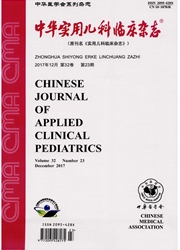

 中文摘要:
中文摘要:
目的探讨体外阿奇霉素诱导肺炎支原体(MP)耐药的发生机制。方法在含亚抑菌质量浓度阿奇霉素的MP培养基中,诱导培养MP国际标准株FH株对大环内酯类抗生素的耐药株;应用体外药物敏感试验,检测诱导株对红霉素的最小抑菌质量浓度(MIC),并筛选出耐药株;测定耐药株对阿奇霉素和交沙霉素的MIC值;通过PCR扩增与大环内酯类抗生素耐药性有关的23SrRNA结构域V区及核糖体蛋白L4、L22基因,并对扩增产物进行全自动DNA测序,测得序列与美国国立生物信息中心已登录的MP标准株M129的相应基因序列进行对比。结果通过体外诱导得到FH体外诱导株8代(YD1-YD8),其中YD1-YD4为敏感株,YD5-YD8为耐药株。耐药株对红霉素、阿奇霉素、交沙霉素的MIC值均显著升高。在与大环内酯类抗生素耐药相关的23S rRNA结构域V区中YD1-YD6诱导株和FH株均未出现点突变,YD7、YD8诱导株均出现了2067位A→G的点突变;在核糖体蛋白L4中,诱导株和FH株均出现了162位C→A和430位A→G的点突变;在核糖体蛋白L22中,诱导株和FH株均出现了279位T→C和508位T→C的点突变。结论 23S rRNA结构域V区中心环的药物作用靶位基因突变是耐药性产生的主要机制。在使用阿奇霉素药物治疗的过程中,有体内诱导出耐药株的可能。
 英文摘要:
英文摘要:
Objective To explore in vitro selection and mechanism of resistance to azithromycin in mycoplasma pneumoniae (MP). Methods Macrolide - resistant MP was selected in vitro from the susceptible reference strain FH, in subinhibitory concentrations of azithromycin. Antibiotic susceptibility test was porformed to identify macrolide - resistant strains through their minimal inhibitory concentration (MIC) of erythromyciu. MIC of azithromycin and josamycine in macrolide -resistant strains were detected. Domain V of 23S rRNA and ribosomal protein IA gene and L22 gene,which were associated with macrolide resistance,were amplified by polymerase chain reaction followed by direct automatic sequencing method. The DNA sequences were compared to the corresponding sequences of MP M129 to find molecular mechanisms of drug resistance. Results Eight serial ( YD1 - YD8 ) passages were selected in vitro from FH strain. The YDI - YD4 passages were susceptivity strains,the YD5 - YD8 passages were macrolide resistance. MIC of these resistant strains to erythromycin azithromycin and josamyeine were elevated. There were no gene mutation of domain V of 23S rRNA in the FH strain and selected passages YD1 - YD6. One point mutation in domain V of 23S rRNA, A2067G, was selected in passages YD7 and YDS. Two point mutations in ribosomal protein IA , C162A and A430G,were found in all the strains, respectively. Two point mutations in ribosomal protein L22, T279C and T508C, were found in all the strains respectively. Conclusions The target mutation in domain V of 23S rRNA may be the predominant mechanism that contribute to the macrohde resistance. There is possibility to induce macrolide - resistant MP in vivo during using maerolide drugs for therapy.
 同期刊论文项目
同期刊论文项目
 同项目期刊论文
同项目期刊论文
 期刊信息
期刊信息
